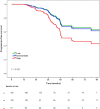Outcomes of Echocardiography-Detected Rheumatic Heart Disease: Validating a Simplified Score in Cohorts From Different Countries
- PMID: 34533041
- PMCID: PMC8649515
- DOI: 10.1161/JAHA.121.021622
Outcomes of Echocardiography-Detected Rheumatic Heart Disease: Validating a Simplified Score in Cohorts From Different Countries
Abstract
Background The natural history of latent rheumatic heart disease (RHD) detected by echocardiography remains unclear. We aimed to assess the accuracy of a simplified score based on the 2012 World Heart Federation criteria in predicting mid-term RHD echocardiography outcomes in children from 4 different countries. Methods and Results Patient-level baseline and follow-up data of children with latent RHD from 4 countries (Australia, n=62; Brazil, n=197; Malawi, n=40; New Zealand, n=94) were combined. A simplified echocardiographic scoring system previously developed from Brazilian and Ugandan cohorts, consisting of 5 point-based variables with respective weights, was applied: mitral valveanterior leaflet thickening (weight=3), excessive leaflet tip motion (3), regurgitation jet length ≥2 cm (6), aortic valve focal thickening (4), and any regurgitation (5). Unfavorable outcome was defined as worsening diagnostic category, persistent definite RHD or development/worsening of valve regurgitation/stenosis. The score model was updated using methods for recalibration. 393 patients (314 borderline, 79 definite RHD) with median follow-up of 36 (interquartile range, 25-48) months were included. Median age was 14 (interquartile range, 11-16) years and secondary prophylaxis was prescribed to 16%. The echocardiographic score model applied to this external population showed significant association with unfavorable outcome (hazard ratio, 1.10; 95% CI, 1.04-1.16; P=0.001). Unfavorable outcome rates in low (≤5 points), intermediate (6-9), and high-risk (≥10) children at 3-year follow-up were 14.3%, 20.8%, and 38.5% respectively (P<0.001). The updated score model showed good performance in predicting unfavorable outcome. Conclusions The echocardiographic score model for predicting RHD outcome was updated and validated for different latent RHD populations. It has potential utility in the clinical and screening setting for risk stratification of latent RHD.
Keywords: echocardiography; follow‐up; prognosis; rheumatic heart disease; screening.
Conflict of interest statement
None.
Figures



References
-
- James SL, Abate D, Abate KH, Abay SM, Abbafati C, Abbasi N, Abbastabar H, Abd‐Allah F, Abdela J, Abdelalim A, et al. Global, regional, and national incidence, prevalence, and years lived with disability for 354 diseases and injuries for 195 countries and territories, 1990–2017: a systematic analysis for the Global Burden of Disease Study 2017. Lancet. 2018;392:1789–1858. doi: 10.1016/S0140-6736(18)32279-7 - DOI - PMC - PubMed
-
- Roth GA, Mensah GA, Johnson CO, Addolorato G, Ammirati E, Baddour LM, Barengo NC, Beaton AZ, Benjamin EJ, Benziger CP, et al. Global burden of cardiovascular diseases and risk factors, 1990–2019: update from the GBD 2019 study. J Am Coll Cardiol. 2020;76:2982–3021. doi: 10.1016/j.jacc.2020.11.010 - DOI - PMC - PubMed
-
- Diamantino A, Beaton A, Aliku T, Oliveira K, Oliveira C, Xavier L, Perlman L, Okello E, Nascimento B, Ribeiro ARP, et al. A focussed single‐view hand‐held echocardiography protocol for the detection of rheumatic heart disease. Cardiol Young. 2018;28:108–117. doi: 10.1017/S1047951117001676 - DOI - PubMed
Publication types
MeSH terms
LinkOut - more resources
Full Text Sources

